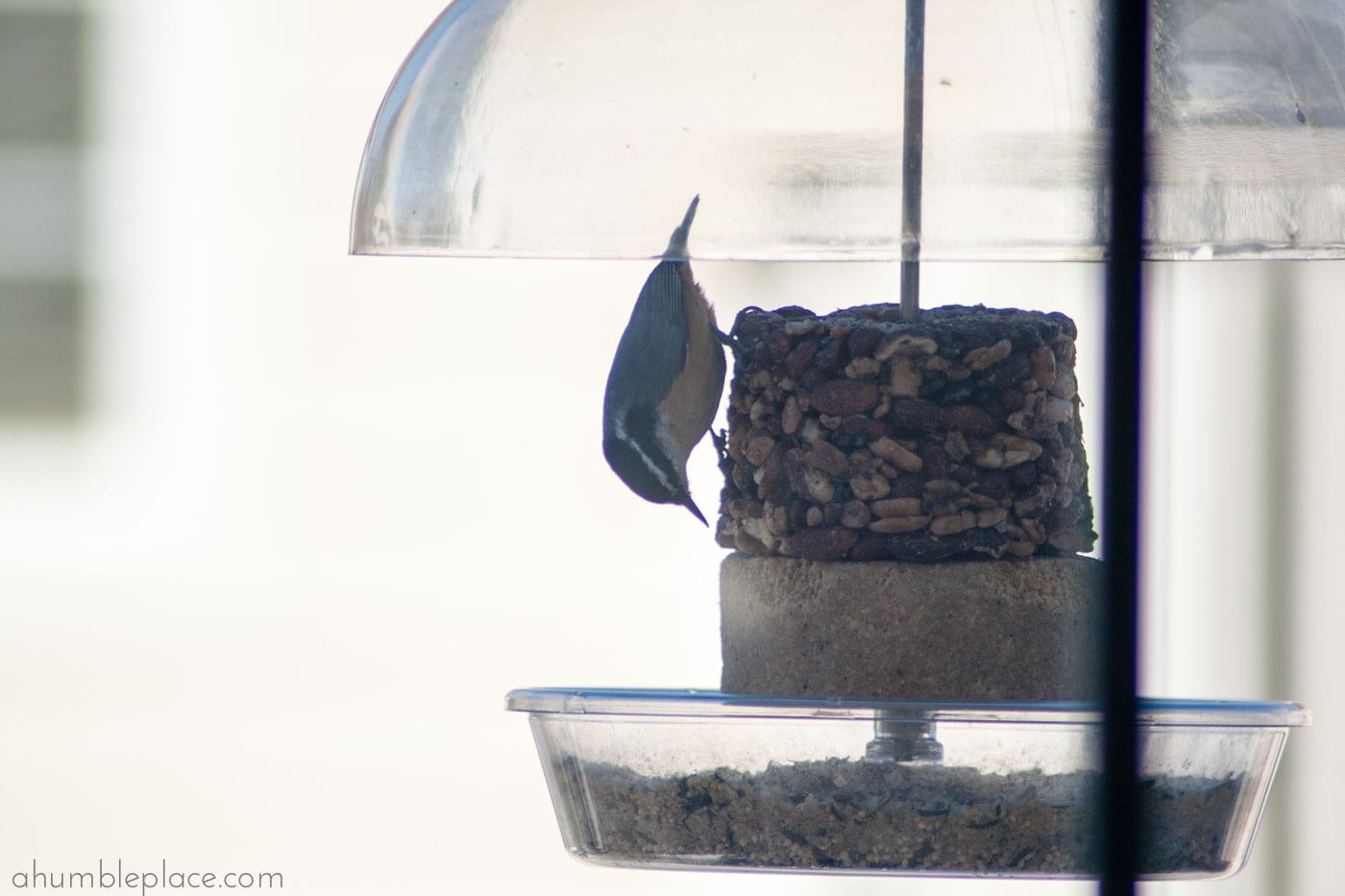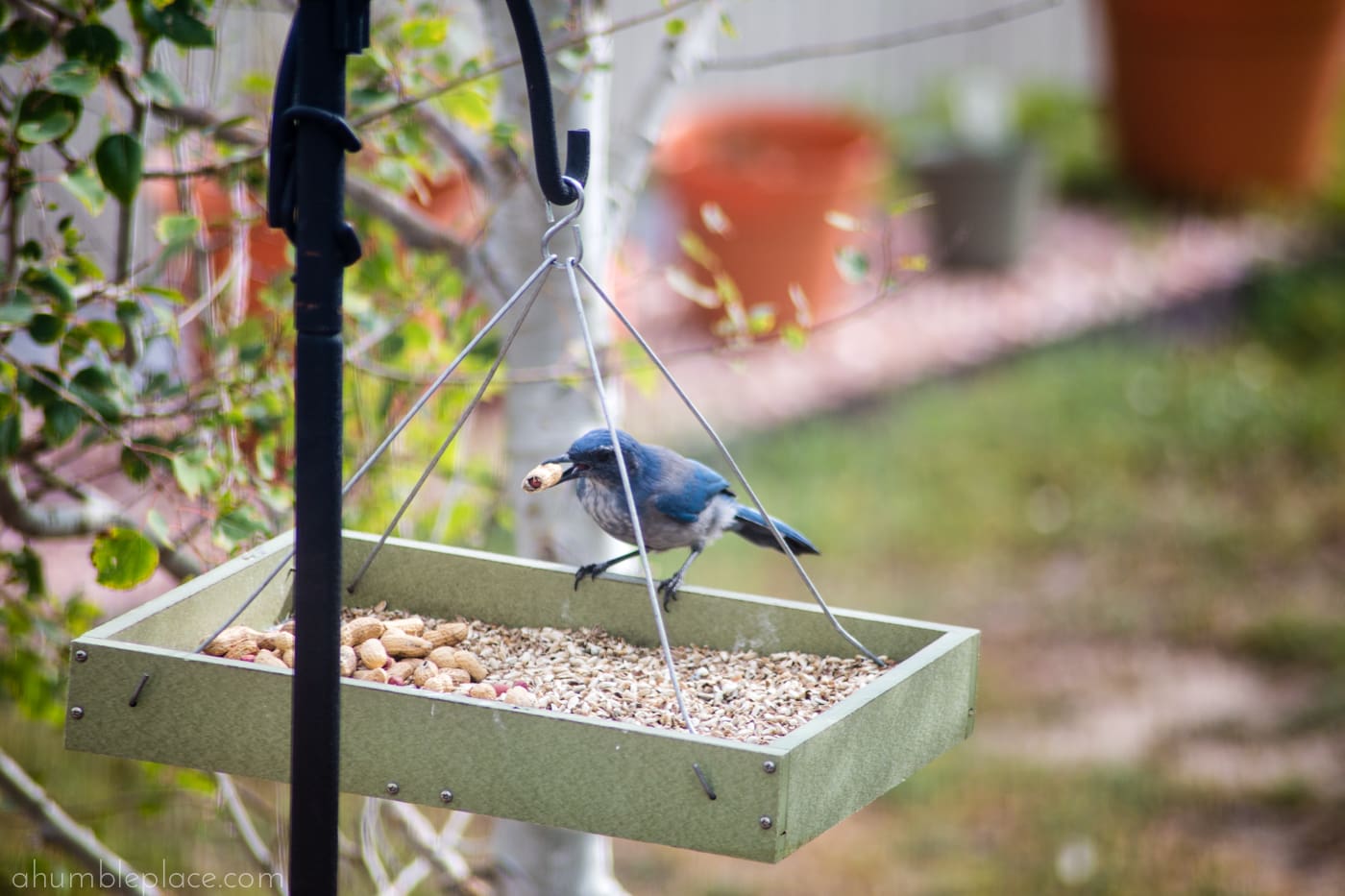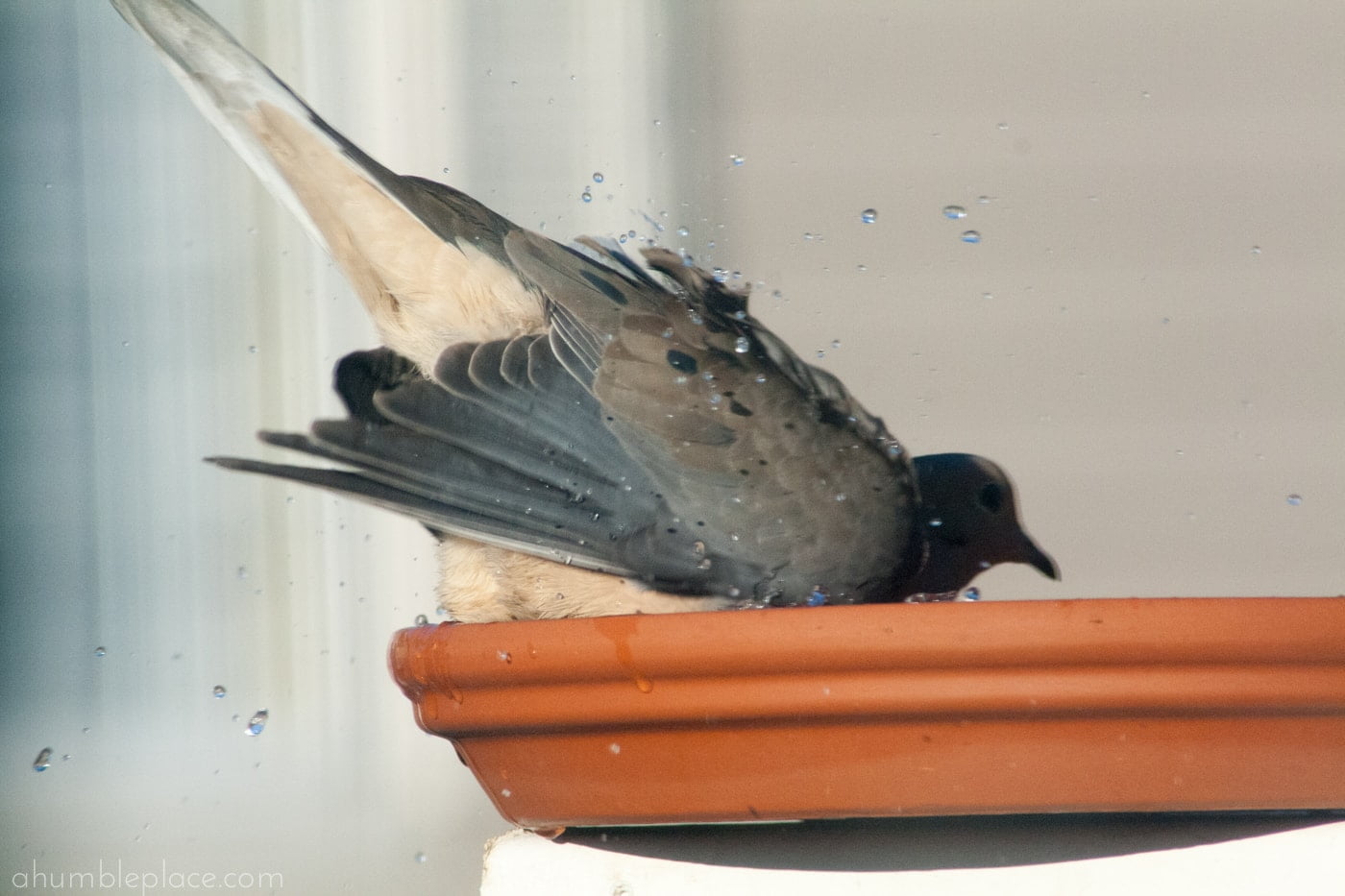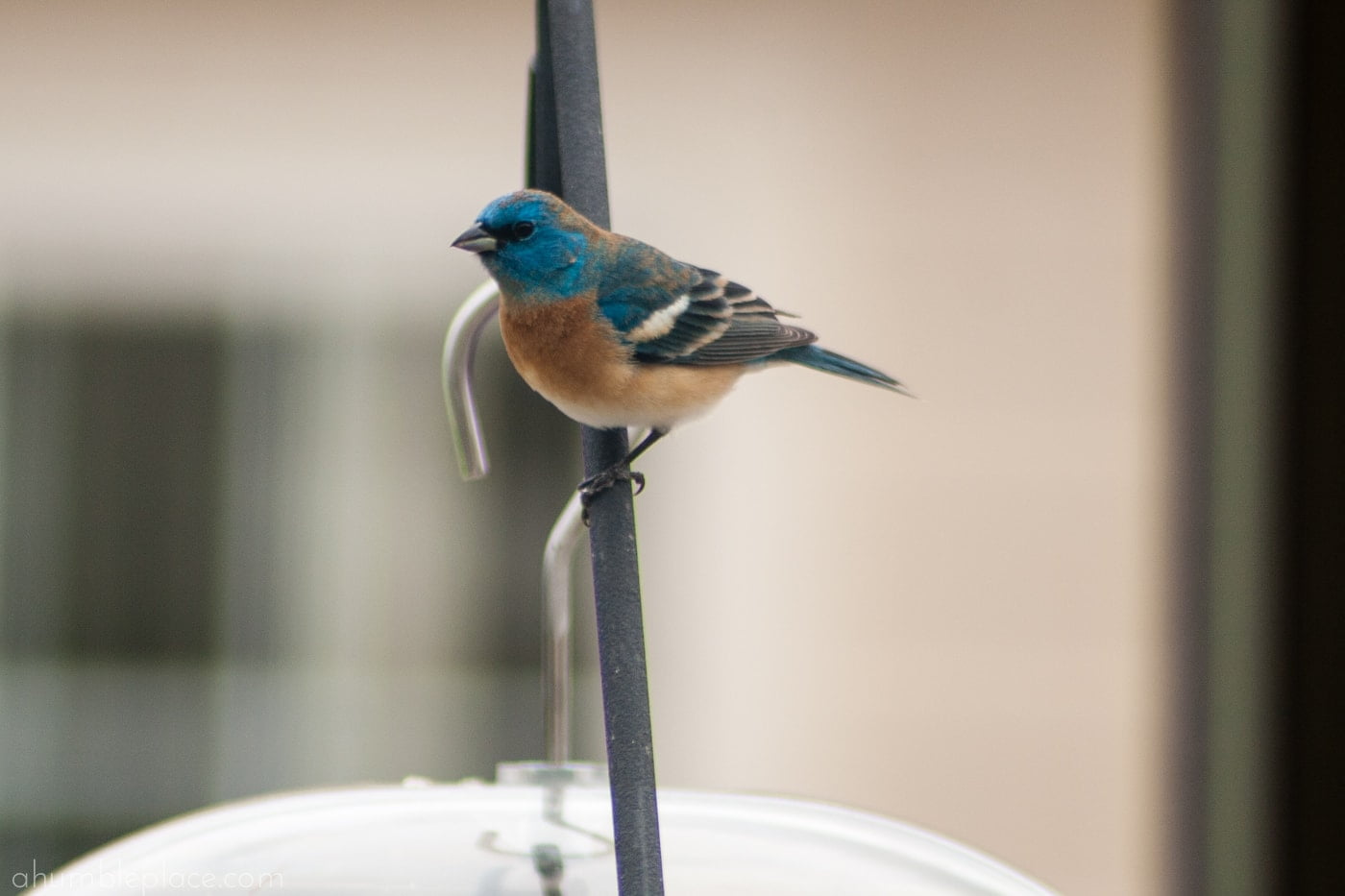Backyard Birding for Beginners
Posted by admin on

Of all the interests and hobbies and activities that people can choose from in this world, I never in a million years thought that I would be as interested in birds as I have turned out to be. I didn’t really think much about them prior to a few years ago…..they just flew through the air and built nests and ate worms and generally were background fodder for life. I knew there were a few different kinds and they were all around the same size and that was about it. They didn’t warrant much more attention than that.
We got our first bird feeder back in 2012 before we became more “serious birders” (I say that with as much levity as I can). We were picking something up at Whole Foods and there was an entire display of these small, locally-made bird feeders that were wooden with little clay dishes in them and painted all kinds of bright colors. I think they were something like $10 or $15, so on a whim (and probably a sense of guilt as we still didn’t have a yard for B, thus he wasn’t being exposed to much nature in his day-to-day life), we got one. I can’t remember at all where we ended up buying the food, but it wasn’t the highest-quality stuff. Still…birds are birds, right? They don’t care.
It took us about a month that first time to get our first house finches despite the fact that it was April and there were birds by the hundreds flying into the neighborhood. I was ecstatic and loved watching them…for a little while, anyway. Then having to refill the little dish every day got old and mold started growing under it and they pooped all over the deck and then suddenly we had a dead dove on our patio (we think he hit the window), so we abandoned the project a few months later.
Then in 2015, we started B’s winter preschool “curriculum,” which included a suggestion to hang a bird feeder near a window so we could observe nature while we were trapped inside during the cold months. We decided to give it another try and went to a local bird store where we picked up a pole system that would keep the birds (and the poop) off our deck. It was set up on the deck immediately after we got home (despite the fact that it was the beginning of January), we got our second set of first birds a few weeks later, and the rest is history.

I could go on and on about why I love birds now, how I had no idea the variety of colors and sizes and behaviors, all the little quirks and idiosyncrasies of the different species until I actually started watching them, but I think the best way to understand this is to observe them for yourself. It’s one of the more calming activities in my life and I’m amazed at how much both the kids and I have picked up and learned about them just by hanging up a backyard feeder.
To make it a little easier for you, I’m sharing some of the things that we’ve used to attract birds to our feeders and what our experiences have been. As is my usual caveat, I’m definitely not an expert “birder,” but hopefully someone out there finds this helpful!
Feeders
The first place to start, logically, is with a feeder. In order to attract the birds, you’ll need to offer them something they want (and, also, need for survival)….food and a place to put it.

Above all, I recommend the Wild Birds Unlimited feeders. They are hardy, beautifully made, easy to clean (and keep clean), and they offer a 30-day warranty (and, in some cases, a lifetime warranty). When we experienced the Hailfest of 2016, during which every single house in our neighborhood had at least $20,000 in damage, our WBU feeders, for the most part, withstood it just fine. At the time, we had a dinner bell feeder that was untouched after the storm passed, and a tray feeder that, while pitted, is still completely functional. The only caveat with the WBU feeders is that their price point is considerably higher than others, so it is an investment. They do LAST though (in comparison with the other feeder we had out there during the hailstorm which literally exploded). They also offer a daily savings club, where you get a discount on all of their feeders and food. Their staff is always incredibly helpful and very eager to answer questions as well.
There are other stores that carry feeders also and the ones I’ve found to have the best selection have been farm supply stores. Here in Colorado, we’ve got Tractor Supply and Murdoch’s. These are definitely not the same quality as the WBU feeders, but they’ll do to start off and in a pinch. And, of course, Amazon offers a wide selection of feeders as well.
In the list below, I’m including links to both the WBU version and one on Amazon with good reviews (though I may not have personal experience with them), or elsewhere if that’s where I have experience. In many cases, WBU offers a lot of discount coupons if you join their mailing list (without joining the savings club), which you can usually do on the individual store pages. They seem to also only be posting the EcoClean versions of their feeders online and we’ve gotten by just fine with our non-EcoClean feeders, which are quite a bit cheaper and can sometimes be found in-store.

You will first need an apparatus from which to hang your feeders, or a pole system. For this, I highly recommend the pole system at Wild Birds. We’ve had this since the beginning and it’s been fantastic. It has withstood blizzards, hail, rain, and 33+ mph winds (which we get in the new house according to our weather station). For those apartment/condo-dwellers among you, or anyone who doesn’t have a yard, they have a clamp version as well that worked beautifully for us in our old house. There’s also an option on Amazon that has good reviews as well.

We started with a dinner bell feeder (WBU; Amazon). These are nice because you can put seed in the bottom, and then a suet or seed cylinder on the pole in the middle, which would allow you to attract a wider range of birds (including nuthatches and woodpeckers). You can also put the cylinders on feeders that are specifically designed for them (WBU; Amazon).
We added a tray feeder at a later date when we started getting larger birds (WBU; Amazon). These can be both really great and also really annoying as they allow for more birds and larger birds to stop by, but also problem birds like cowbirds and grackles to take over your feeder. I’ll address that later.

When we started getting a few American and lesser gold finches , we added a feeder just for nyjer/thistle seed. This seed is very, very tiny, so you can only offer it with special feeders, but these don’t have to be expensive at all. In fact, we started with a sock feeder (WBU; Amazon) and then later got a column feeder just for them (this one in particular and then later this one – here’s a similar one on Amazon), though even then, they preferred the sock feeder. House finches and supposedly chickadees will also eat nyjer/thistle, though I haven’t had success with the latter.

I mentioned earlier that you can add a bird seed/suet cylinder to the dinner bell feeder above and that will also attract woodpeckers which are fun to watch at feeders. Two of my favorites in the old house were a northern flicker who would wrap himself around the bottom of the feeder bowl and peck at the column, and a downy woodpecker, which we later had to bring to a wild animal rehabilitator when we think she flew into a wall. They also make special feeders just for woodpeckers (WBU; Amazon) that have a little “prop” on the bottom part to help them balance with their tails better. So far, we haven’t had anything other than finches and chickadees pecking at the one we have now, but I’m hopeful we’ll get a little more variety the longer we’re here. It did take us at least a year to get them at the old house.

A peanut feeder can be a nice addition as well if you want to attract jays and magpies, but isn’t necessary as we just threw peanuts in the tray or out on the porch before we got a feeder. We have a simple column feeder specifically for peanuts in the shell (WBU; Amazon [not a column but functions the same way]) as we often get magpies (who are quite creative in balancing their massive bodies and tails on the column), scrub-jays, blue jays, grackles (who also apparently like peanuts), and the occasional crow. The benefit to having a feeder is that you can put more out so you’re sure to have peanuts available when the jays or magpies actually show up rather than having to keep an eye out for them so you can throw some out to them.

We finished off our collection with a feeder for a seasonal favorite: hummingbirds. Our original hummingbird feeder, probably the most common design available, was somewhat successful, but it was a pain to clean and we wasted a lot of “nectar” because we had to fill it up so far in order for it to work properly. The nectar began to get moldy after just a few days in the hot summer sun, so I wasn’t a big fan of that design. Not long after we moved into the new house, I picked up a hummingbird feeder that suction-cupped to the window, not expecting it to work at all.
Surprisingly, it has become my new favorite feeder as it’s so easy to clean (it rinses out well and you can stick in the dishwasher which is very important as hummingbirds are particularly finicky), and I get an up-close and personal view of the hummingbirds. This feeder always goes out on April 15th (because tax day = hummingbird day) and because we get broad-tails here, it’s been fun to hear their trill little wings again as they stop to take a drink. This year, before they found our feeder, I saw them hovering around the brake lights on our neighbors’ cars….they’re not the smartest little birds. (I’d also love to try this feeder, but I don’t think we get enough of them for that.) We leave this feeder out until mid-September.

Food
Of course, you need to fill those feeders with something. I do think quality is something to pay attention to when you’re buying birdseed. There are some brands out there that offer a lot of fillers like milo or other grains that birds generally don’t eat as readily, or they dye their seeds bright colors which is not necessary. In fact, a bag of seed we bought before we “knew better” had seeds of some kind that had been dyed pink. Can you guess which seeds the birds didn’t eat?
Quality is important not only because it’s better for the birds, but also because it’s better for your wallet. If you buy a 20 lb. bag of cheap birdseed, you may be saving a few dimes per pound, but when you end up throwing quite a bit of it out because the birds discard it or ignore it, you’re not really saving much. Also, if you offer a good variety of bird food, which you’ll find in bags that are more expensive than the cheaper stuff, you’ll attract a wider variety of birds. Believe it or not, birds don’t agree with the old adage that beggars can’t be choosers and can actually be quite picky.

We’ve had the most success in terms of attracting different birds and not wasting seed with the Wild Birds Unlimited blends. They offer different options based on what your needs might be or types of birds you’re trying to attract, including a few no-mess blends that are ideal if you’re in an apartment or condo situation and don’t want a bunch of seeds or shells discarded to the floor or ground below your deck. This is also nice if you don’t want random plants growing under your feeders. Now that we have a yard, I actually prefer getting the messy blends because then we get the birds who usually only eat seed on the ground (like juncos, chipping sparrows, towhees, and white-crowned sparrows).
Their food is definitely more expensive than what you’ll find at the grocery store or Home Depot. They do, however, also offer a discount on bird food if you’re part of their daily savings club and they often have sales where you earn more points on bird food as well as coupons for those signed up for their mailing lists. Some stores also offer a free bag of birdseed on your birthday, though this varies by location.

We switch out the types of food we use depending on the time of year. I always have nyjer (WBU; Amazon; Tractor Supply) out for the goldfinches since they’re here all year (Americans stay through the winter and we have lessers starting in the spring through late fall).

During the colder months, I put out a basic mix in the tray as there aren’t as many birds around (mostly juncos, house finches, collared-doves, and chickadees). Right now we’re putting out this one from Wild Birds Unlimited, but there are several types available (WBU; Amazon). It does, however, contain millet which less desirable birds like cowbirds (who can be quite nasty to other birds) and house sparrows (which are non-native birds and quickly take over areas, driving other species, like bluebirds, out) like to eat. But Juncos also like millet, so it goes both ways.

For this reason, when the cowbirds and grackles return to the area in the spring (and subsequently take over our feeders), we switch the tray to safflower (WBU; Amazon: Tractor Supply) which some refer to as the “problem solver.” Most blackbirds and squirrels won’t eat it (and may actually spit it out and throw a fit when they find that their normal food has been replaced which is very amusing to watch), so it’s very effective in keeping your feeding to songbirds. We’ll leave the safflower out until late September or early October.
If squirrels or other animals are a problem at your feeders, you can also try a baffle (WBU; Amazon) which has worked well for us in keeping the squirrels off our pole system. Be careful not to put your feeders near trees in this case as, if they are too close to something else on which the squirrel can climb, they will find a way around the baffle.

Peanuts are probably the easiest bird food. We get them in the shell because we were specifically aiming to attract jays, though I have seen chickadees fly off with an entire peanut in their tiny bills. Other types of birds do like them out of the shell, so that’s another option. Right now we just buy unsalted, roasted peanuts at Costco (they’re about $6 for a 5 lb. bag) which have worked just fine for us, but you can also buy peanuts that are sold specifically for wild birds (WBU; Amazon). If you do decide to buy non-bird food peanuts, make sure they’re unsalted.

Stackables or cylinders are excellent and usually inexpensive ways to add a little more variety to your feeding stations. Usually, you can find suet mixed with various other types of food (like bugs, berries, or nuts) to attract different kinds of birds. With our setup, we usually either get a nut cylinder or stackable to go on our dinner bell feeder or a nut/berry cake to go in our woodpecker feeder. The WBU suet is especially nice because it doesn’t melt when the temperature climbs. You can also buy feeders specifically designed for suet (WBU; Amazon) or just buy the cakes and break them apart in a tray (though they won’t last as long).

For hummingbird nectar, I just boil 4 cups of water, dump in a cup of sugar, mix it well and store it in the fridge. Dyeing it red is not necessary and may actually be harmful for the birds, so we leave it au naturale.

And, of course, remember to get your birds a birdbath, which will allow you to attract non-feeder birds (like robins and hawks!) as well.
Other Food

There are many other types of food you can include in your feeding apparatus that will attract various birds. Mealworms, for instance, are a popular meal for robins, bluebirds, chickadees, cardinals, nuthatches, and woodpeckers. In the spring, they are also helpful to nesting parents as they can feed them to their babies. You can buy a bag of mealworms (WBU; Amazon) and mix it in with your other seed, or offer it on its own.
If you want to attract orioles to your yard, you can buy special feeders (WBU; Amazon) to offer jelly and oranges. We have yet to do this as I haven’t seen any orioles in our area and the wind can be very strong at times, but I do hope to at least put out some orange slices soon to see if any stop by.
Corn cobs are another easy feeder idea that will attract other creatures, like squirrels. We have a special squirrel feeder (similar to this) that has a post for a corn cob as well as a holder for peanuts and the magpies, jays, and squirrels visit it whenever it’s full.
One of the more natural ways to feed birds is to add plants to yard that they eat in the wild. Many birds flock to berry plants and the first year we lived in this house, we had cedar waxwings gravitating toward our cherry tree, which was very exciting as they are one of my favorite birds. Since then, we’ve discovered that sunflowers will also attract many birds. Because of our feeders, we’ve had a lot of wild sunflowers coming up around our patio and, even though they’re a tiny bit unsightly at the end of their growing season, we let them grow as the birds, especially goldfinches and chickadees, love them.

Resources
Now that you have your setup and all these little winged creatures visiting your feeders, how do you identify them? The Stokes Field Guide to Birds is my favorite book for identifying backyard birds as it will tell you which ones tend to come to feeders (it’s actually kind of big to use as a field guide, so I wouldn’t recommend it for that). Unfortunately, it was published in 1996, so some of the species maps are a little outdated. They do have an updated version, but it doesn’t include feeding info. Another one specific for backyard bird feeding that looks good but I haven’t had a chance to look at yet is The Joy of Bird Feeding. For an actual field guide, I like Stan Tekiela’s Bird Field Guides as they’re easy to carry in a pocket.

If you have a smartphone, apps are actually probably the best way to identify birds if you’re not already somewhat familiar with your local varieties. Cornell University’s Merlin Bird ID app (free) was especially helpful when we moved into our current house as we got a few new birds here that we had never seen at the old house. They also offer a tool that will identify birds from a photo, but I haven’t tried it yet. We also tried iBird, but Merlin works just as well and is free.
To get the kids more involved in the bird nerdery, we picked up a used copy of Birdsongs a few years ago, that they have subsequently trashed because they’ve used it so much. I was happy to find out there are now newer versions that focus specifically on backyard birds. We also enjoy an occasional game of bird bingo and I would also like to pick up these beautiful flash cards as well.
To experience birds outside of those you might see in your backyard up close and personal, we’ve been tuning into the Cornell Lab Bird Cams on the YouTube channel on our Roku. It’s been neat to observe their different patterns and habits as well as being able to show the kids the birds being laid, incubated, and hatched and, of course, they love the baby birds.

And, if you want to step up the bird nerdness even more, you can tune in every Saturday to Bird Talk which is a radio show and podcast delivered by owners of a few Wild Birds stores in Denver. Their humor is dry and cheesy at times, which is fun, and they’re extremely knowledgable. I’ve learned a lot just from listening to the show.
And that pretty much sums up what we’ve learned in the last seven years of “birding.” This is definitely a hobby I plan on keeping and hopefully growing in my kids. 
The post Backyard Birding for Beginners appeared first on a humble place.
